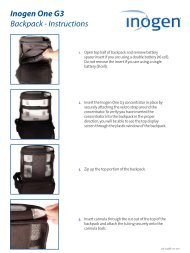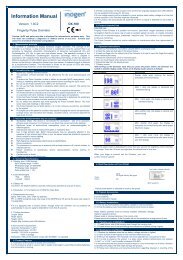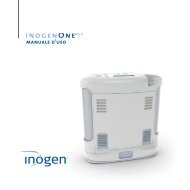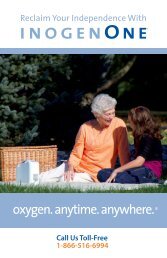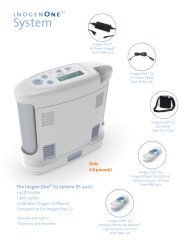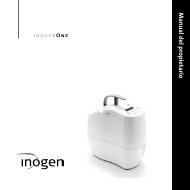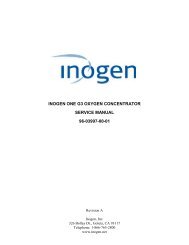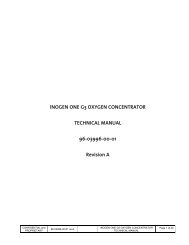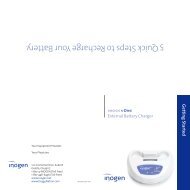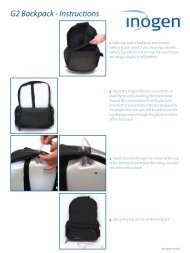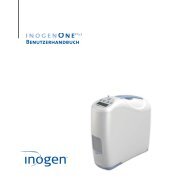Up to 50% of continuous flow oxygen therapy patients ... - Inogen One
Up to 50% of continuous flow oxygen therapy patients ... - Inogen One
Up to 50% of continuous flow oxygen therapy patients ... - Inogen One
Create successful ePaper yourself
Turn your PDF publications into a flip-book with our unique Google optimized e-Paper software.
<strong>Inogen</strong> has completed and published<br />
more clinical data surrounding the<br />
<strong>Inogen</strong> <strong>One</strong> than any other available<br />
<strong>oxygen</strong> <strong>therapy</strong> product.<br />
<strong>Inogen</strong> Specific Research<br />
1. Stegmaier JP. Chatburn RL, Lewarski JS. “Determination <strong>of</strong> an Appropriate Nocturnal<br />
Setting for a Portable Oxygen Concentra<strong>to</strong>r with Pulsed-Dosed Delivery.” Abstract.<br />
Respir Care November 2006;51(11): 1305.<br />
Summary: The purpose <strong>of</strong> this study was <strong>to</strong> determine if a single titration <strong>of</strong> <strong>oxygen</strong><br />
using a POC during ambulation/exercise would provide an appropriate setting for<br />
nocturnal use. The results suggested that an <strong>oxygen</strong> setting selection based on<br />
daytime ADL/ambulation appears <strong>to</strong> produce effective nocturnal <strong>oxygen</strong> <strong>therapy</strong><br />
as evidenced by a mean sleeping SpO 2 <strong>of</strong> 92% and no clinically significant<br />
desaturation.<br />
2. Chatburn, R, Lewarski J, McCoy R. “Nocturnal <strong>oxygen</strong>ation using a pulsed dose<br />
<strong>oxygen</strong> conserving device compared <strong>to</strong> <strong>continuous</strong> <strong>flow</strong> <strong>oxygen</strong>.”<br />
Respir Care March 2006;51(3): 252-256<br />
Summary: The study compared nocturnal <strong>oxygen</strong>ation with <strong>continuous</strong> <strong>flow</strong><br />
versus the <strong>Inogen</strong> <strong>One</strong> among a group <strong>of</strong> established LTOT users with chronic<br />
lung disease. The results demonstrate that when appropriately titrated, the<br />
<strong>Inogen</strong> <strong>One</strong> is essentially clinically equivalent <strong>to</strong> <strong>continuous</strong> <strong>flow</strong> <strong>oxygen</strong>.<br />
The study also suggests that daytime pulse dose titrations may be effective<br />
in determining nocturnal <strong>oxygen</strong>ation.<br />
3. Case, R, Hausmann R. “Use <strong>of</strong> a portable <strong>oxygen</strong> concentra<strong>to</strong>r with a fixed minute<br />
volume <strong>oxygen</strong> conserving device <strong>to</strong> deliver <strong>oxygen</strong> <strong>to</strong> exercising pulmonary<br />
rehabilitation <strong>patients</strong>.” Abstract.<br />
Respir Care November 2005;50(11):1510.<br />
Summary: The study concluded that the <strong>Inogen</strong> <strong>One</strong> was as clinically effective as<br />
<strong>continuous</strong> <strong>flow</strong> <strong>oxygen</strong> at maintaining target SpO 2 levels in high <strong>flow</strong> (4-5 lpm)<br />
<strong>oxygen</strong> users during intense exercise.<br />
4. McCoy, R, Lewarski, J. “A test for clinical equivalency: A portable concentra<strong>to</strong>r with<br />
integrated <strong>oxygen</strong>-conserving compared <strong>to</strong> <strong>continuous</strong> <strong>flow</strong> <strong>oxygen</strong> during<br />
nocturnal use.” Abstract.<br />
Respir Care November 2005; 51 (11):<br />
Summary: This study demonstrated the <strong>Inogen</strong> <strong>One</strong> TM POC was able <strong>to</strong> deliver<br />
adequate nocturnal <strong>oxygen</strong> <strong>therapy</strong> as evidenced by <strong>continuous</strong> SpO 2 moni<strong>to</strong>ring<br />
in 9 <strong>of</strong> 10 (90%) <strong>of</strong> <strong>patients</strong> studied. The resting daytime <strong>oxygen</strong> titration and the<br />
resultant SpO 2 appears <strong>to</strong> be reasonably effective method for determining an<br />
appropriate nocturnal <strong>oxygen</strong> setting.<br />
6



